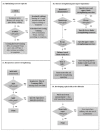Therapist Driven Rehabilitation Protocol for Patients with Chronic Heart and Lung Diseases: A Real-Life Study
- PMID: 32033505
- PMCID: PMC7037983
- DOI: 10.3390/ijerph17031016
Therapist Driven Rehabilitation Protocol for Patients with Chronic Heart and Lung Diseases: A Real-Life Study
Abstract
Therapist driven protocols may help to tailor rehabilitation programs to individual patients. We aimed to test the feasibility, safety, and clinical usefulness of a therapist driven protocol for rehabilitation including exercise training of patients with heart or lung diseases. An internal audit elaborated the Cardio-Respiratory Exercise Maugeri Algorithm (CREMA) based on: (a) standardized baseline assessments, (b) decision-making pathways, and (c) frequency/intensity/time/type (FITT) of prescription for each exercise. Outpatients (n = 620) with chronic heart disease (CHD), recent myocardial revascularization (REVASC), chronic airway (Obstructive), and restrictive lung (Restrictive) diseases underwent exercise training according to CREMA during 4 years. Peripheral muscle strengthening was the most prescribed exercise (83.6%), while arm endurance training was the least frequently (0.75%). Exercise prescription varied widely among the disease groups (interval training 19-47%, balance 35-49%, lower limb muscle training 6-15%). After training, REVASC patients were the best improvers in the 6 min walking distance (+48.7 (56.1) m), maximal inspiratory pressure (+9.6 (15.4) cmH2O), and daily steps (+1087.2 (3297.1) n/day). Quadriceps and biceps strength, maximal expiratory pressure, and balance improved in all groups, without significant differences. Minor side effects were observed in 11.2% of the patients. The CREMA therapist driven protocol was feasible, safe, and useful for prescribing tailored training programs. Exercise prescriptions and training response differed among diseases.
Keywords: algorithm; cardiac rehabilitation; exercise; physiotherapist protocol, driven protocols; pulmonary rehabilitation; training.
Conflict of interest statement
The Authors have no conflict of interest to disclose related to the manuscript.
Figures
References
-
- Spruit M.A., Singh S.J., Garvey C., ZuWallack R., Nici L., Rochester C., Hill K., Holland A.E., Lareau S.C., Man W.D., et al. An official American Thoracic Society/European Respiratory Society statement: Key concepts and advances in pulmonary rehabilitation. Am. J. Respir. Crit. Care Med. 2013;188:e13–e64. doi: 10.1164/rccm.201309-1634ST. - DOI - PubMed
-
- Perk J., De Backer G., Gohlke H., Graham I., Reiner Z., Verschuren W.M., Albus C., Benlian P., Boysen G., Cifkova R., et al. European Guidelines on Cardiovascular Disease Prevention in Clinical Practice (version 2012). The Fifth Joint Task Force of the European Society of Cardiology and other societies on cardiovascular disease prevention in clinical practice (constituted by representatives of nine societies and by invited experts) G. Ital. Cardiol. 2013;14:328–392. - PubMed
Publication types
MeSH terms
LinkOut - more resources
Full Text Sources
Medical



